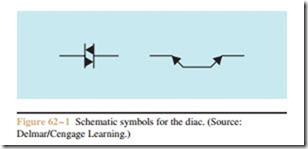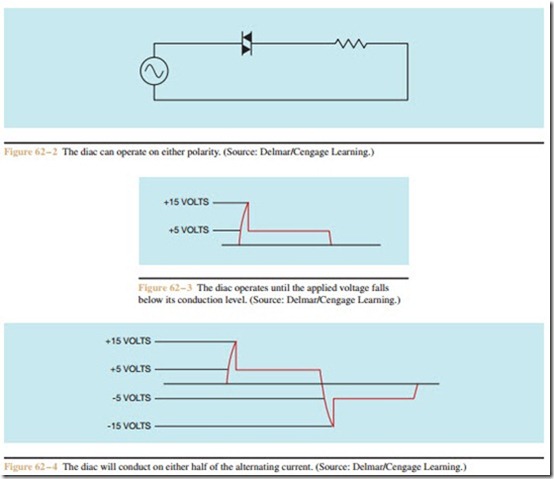THE DIAC
The diac is a special-purpose, bidirectional diode. The primary function of the diac is to phase shift a triac. The operation of the diac is very similar to that of a unijunction transistor, except that the diac is a two-directional device. The diac has the ability to operate in an AC circuit while the UJT can operate only in a DC circuit.
There are two schematic symbols for the diac (Figure 62–1). Both of these symbols are used in electronic schematics to illustrate the use of a diac. Therefore, you should make yourself familiar with both symbols.
The diac is a voltage sensitive switch that can operate on either polarity (Figure 62– 2). Voltage applied to the diac must reach a predetermined level be- fore the diac will activate. For this example, assume that the predetermined level is 15 volts. When the voltage reaches 15 volts, the diac will turn on, or fire. When the diac fires, it displays a negative resistance, which means that it will conduct at a lower voltage than the voltage needed to turn it on. In this example, assume that the voltage drops to 5 volts when the diac conducts. The diac will remain on until the applied voltage drops below its conduction level, which is 5 volts (Figure 62– 3).
Since the diac is a bidirectional device, it will conduct on either half cycle of the alternating current applied to it (Figure 62– 4). Note that the diac operates in the same manner on both halves of the AC cycle. The simplest way to summarize the operation of the diac is to say that it is a voltage sensitive AC switch.
Review Questions
1. Briefly explain how a diac operates.
2. Draw the two schematic symbols used to represent the diac.
3. What is the major use of the diac in industry?
4. When a diac first turns on, does the voltage drop, re- main at the same level, or increase to a higher level?

